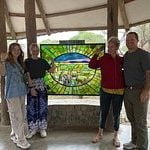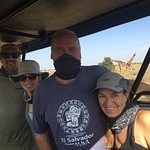Overview
On Kilimanjaro’s northeastern side, the Rongai Route provides a less traveled route to the summit. Rongai, in contrast to some of the busier routes, offers a serene and secluded experience, ideal for those seeking solitude amidst the magnificence of nature.

History of the Rongai Route
The Rongai Route has a fascinating history that adds to its allure and significance as a Kilimanjaro trekking path.
- Origins and Early Use – The Rongai Route traces its origins back to ancient times when local Chagga people utilized the path for trade and cultural exchanges between the slopes of Kilimanjaro and the Kenyan Maasai tribes. The Chagga, who have lived around Kilimanjaro for centuries, were intimately familiar with the mountain’s terrain and utilized the Rongai trail for its accessibility and safety.
- Colonial Exploration – During the late 1800s, European explorers and missionaries began to venture into East Africa, including the region around Kilimanjaro. The Rongai Route gained prominence as one of the initial routes used by these explorers to ascend the majestic peak. Its approach from the northern side provided a different perspective of the mountain, which was not well-documented before.
- Early Expeditions – One of the earliest documented successful expeditions using the Rongai Route was led by German geologist Hans Meyer in 1894. Meyer’s expedition, accompanied by Austrian mountaineer Ludwig Purtscheller, reached the summit via the Rongai Route, marking the first recorded ascent of Kilimanjaro.
- Cultural Significance – For the local Chagga people, Kilimanjaro holds immense cultural and spiritual significance. They believe that the mountain is a dwelling place for ancestral spirits, and it plays a central role in their religious ceremonies and rituals. The Rongai Route, being part of the Chagga’s historical territory, holds a special place in their cultural heritage and traditions.
Advantages of Choosing the Rongai Route
One of the main advantages of the Rongai Route is its gradual ascent, which allows for better acclimatization and reduces the risk of altitude sickness. Moreover, the route offers breathtaking views and diverse landscapes, adding to the allure of the journey.
Best Time to Trek the Rongai Route
The best times to tackle the Rongai Route are from January to March and June to October when the weather is relatively dry and stable. These periods provide favorable conditions for a successful and safe climb.
Preparing for the Journey
- Understanding the Fitness Requirements – While the Rongai Route is considered less challenging than some other routes, it still demands a good level of physical fitness. Engaging in regular cardiovascular and strength training exercises in the months leading up to the trek will significantly enhance your chances of success.
- Acquiring the Necessary Permits and Gear – Securing the required permits well in advance is crucial, as the number of daily climbers is limited. Additionally, investing in high-quality gear, including suitable clothing, footwear, and camping equipment, is essential for a comfortable and safe expedition.
- Mental Preparedness – Conquering Kilimanjaro is not only a physical endeavor but also a mental one. Maintaining a positive attitude, being adaptable, and staying determined will contribute to a more enjoyable and rewarding experience.
Challenges Along the Way
- Dealing with Altitude Sickness – As you ascend higher, the air becomes thinner, and altitude sickness becomes a genuine concern. Understanding the symptoms and taking appropriate measures, such as proper acclimatization and hydration, are crucial for a safe climb.
- Navigating Tricky Terrain – Some sections of the Rongai Route demand steady footwork and focus. Rocky paths and steep ascents can be physically demanding, requiring careful navigation.
- Coping with Changing Weather Conditions – The weather on Kilimanjaro can be unpredictable, with temperatures ranging from scorching heat to freezing cold. Being prepared for sudden weather changes is essential to stay comfortable and safe.
7 DAY RONGAI ITINERARY
DAY 1 – Rongai Gate to Rongai Cave
Before making the quick transfer to the Rongai Gate trailhead, we travel from Moshi to Marangu Gate to obtain permits. The path meanders through fields of corn and potatoes before gently ascending through a forest, where various animals live, including the black and white colobus monkey.
Elevation: 6,398 ft to 9,300 ft
Hiking Time: 3-4 hours
Distance: 8 km | 5 miles
Habitat: Rain Forest
DAY 2 – Rongai Cave to Second Cave to Kikelewa Cave
This morning, we start with a gradual ascent to Second Cave. Following a smaller path that leads to the craggy peaks of Mawenzi, we continue our trek through moorland before arriving at Kikelewa Cave for the night.
Rongai Cave to Second Cave
Elevation: 9,300 ft to 11,300 ft
Hiking Time: 3-4 hours
Distance: 6 km | 4 miles
Habitat: Health
Second Cave to Kikelewa Cave
Elevation: 11,300 ft to 11,811 ft
Hiking Time: 3-4 hours
Distance: 6 km | 4 miles
Habitat: Health
DAY 3 – Kikelewa Cave to Mawenzi Tarn
Today’s hike is a quick ascent of a grassy slope. Beautiful views of the wilderness area can be seen. The landscape drastically changes as we move from the heath zone into the Alpine Desert zone. At Mawenzi Tarn, our camp is located beneath the craggy spires of Mawenzi. The rest of the day can be used for leisure activities or local exploration.
Elevation: 11,811 ft to 14,160 ft
Hiking Time: 3-4 hours
Distance: 5 km | 3 miles
Habitat: Alpine Desert
DAY 4 – Mawenzi Tarn to Mawenzi Ridge to Mawenzi Tarn
You can go day hiking on Mawenzi Ridge on this additional day for acclimatization. The unusual topography provides inspiring views of Kibo and Mawenzi. We briefly stroll around the area before returning to Mawenzi Tarn to set up camp.
Mawenzi Tarn to Mawenzi Ridge
Elevation: 14,160 ft -14,400 ft
Hiking Time: 1-2 hours
Distance: 2 km | 1 mile
Habitat: Alpine Desert
Mawenzi Ridge to Mawenzi Tarn
Elevation: 14,400 ft -14,160 ft
Hiking Time: 1-2 hours
Distance: 2 km | 1 mile
Habitat: Alpine Desert
DAY 5 – Marwenzi Tarn to Kibo Hut
We gradually ascent before crossing the “Saddle” between Mawenzi and Kibo, a lunar desert. At the base of the Kibo crater wall is where our camp, Kibo Hut, is located. After arriving, we take a nap and eat a light dinner to get ready for the summit day.
Elevation: 14,160 ft to 15,430 ft
Hiking Time: 5-6 hours
Distance: 8 km | 5 miles
Habitat: Alpine Desert
DAY 6 – Kibo Hut to Uhuru Peak to Horombo Hut
We start our ascent of the summit very early (around midnight). The hardest part of the trek both mentally and physically is this. At this altitude and time of day, it can be extremely windy and cold. We climb in the dark for several hours, stopping occasionally for brief rests. You will be rewarded with the most spectacular sunrise you are ever likely to see at Gilman’s Point (18,600 feet), which will be coming over Mawenzi Peak. The highest point on Mount Kilimanjaro and the continent of Africa, Uhuru Peak, is finally reached.
We descend to Horombo Hut after pausing for a short while to admire your accomplishment and the African plains. We have our final meal on the mountain later in the evening before a well-earned rest.
School Hut to Uhuru Peak
Elevation: 15,430 ft to 19,341 ft
Hiking Time: 6-8 hours
Distance: 6 km | 4 miles
Habitat: Arctic
Uhuru Peak to Horombo Hut
Elevation: 19,341 ft to 12,250 ft
Hiking Time: 4-5 hours
Distance: 16 km | 10 miles
Habitat: Health
DAY 6 – Horombo Hut to Marangu Gate
We have a long, mostly downhill trek through the tropical rainforest on our final day. We pick up our summit certificates once we arrive at the park headquarters at the Marangu gate. We’ll be met by a car that will take us back to the Moshi Hotel.
Elevation: 12,205 ft to 6,046 ft
Hiking Time: 5-7 hours
Distance: 20 km | 12 miles
Habitat: Rain Forest






